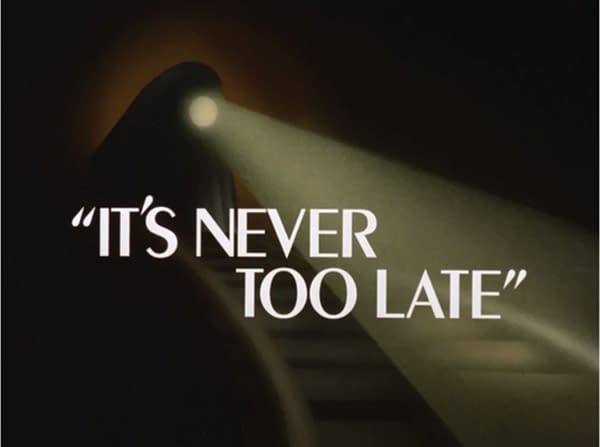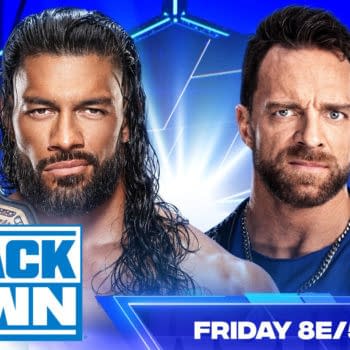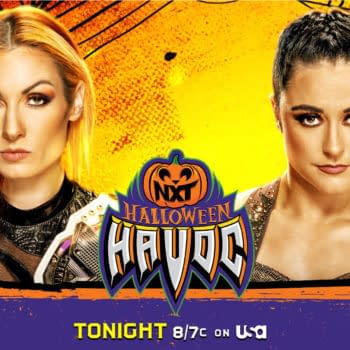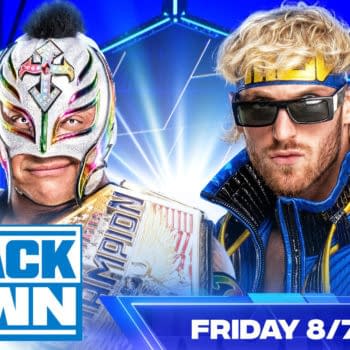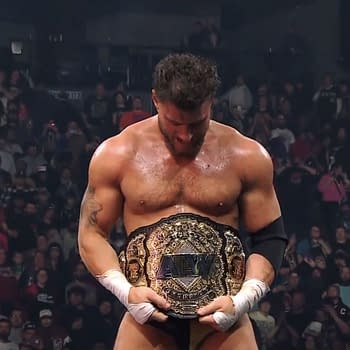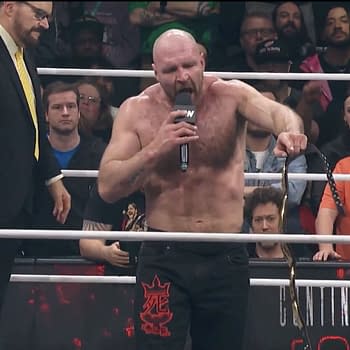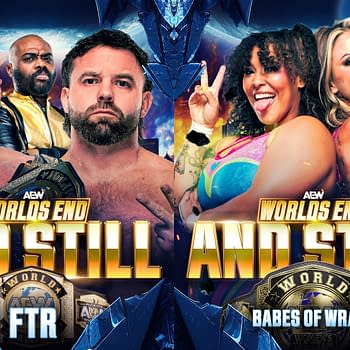Posted in: Cartoon Network, Fox, Review, TV, Warner Animation Group | Tagged: Batman, batman tas, batman the animated series, bruce timm, bruce wayne, dc comics, Kevin Conroy, Warner Bros, WB
Batman: The Animated Series Rewind Review: S01E06 It's Never Too Late
Welcome back Bat-fans as we take a walk down Batman memory lane and rewatch Batman: The Animated Series for its 30th anniversary! Today we're going to take a look at one of the more overlooked episodes of the first season, as it doesn't have a famous supervillain or anything like that, but that doesn't hurt the quality of the episode. Here we'll see Gotham's mafia underworld as Batman deals with two warring gangs in "It's Never Too Late."

It's Never Too Late (Original Air Date: 9/10/1992)
The official synopsis for the episode: "An aging Mob boss learns his drug dealings have contributed to his son's drug addiction." This was the sixth episode to air, but the twelfth produced. Again, this isn't a story about a supervillain or Batman slugging it out with a monster, but rather a throwback to some of Batman's earliest appearances in Detective Comics. Before there were Jokers and Riddlers to deal with, he was simply a man trying to protect his city from a very real criminal element that threatened the character's creators in real life every day in 1930s New York City: the mob.
As much as Batman's creation was inspired by costumed pulp characters like Zorro and The Shadow, the city he operated in, and the criminal elements that haunted and maybe even controlled it was inspired by Warner Bros. gangster films of the 1930s. Gotham City was always a hybrid of the real New York City and the noir, shadow-smothered hell of those classic crime stories. Reading those original Batman tales, you could easily imagine James Cagney, Edward G. Robinson, and George Raft strolling the alleys of Gotham, anxiously looking over their shoulders for a winged shadow. Hell, the iconic cover to Detective Comics #27 (Batman's debut) shows him attacking a group of gangster-looking criminals on a rooftop.
At that point, there was no such thing as a "rogues gallery" or the costumed supervillain whose gimmick rivaled that of the hero. If you lived in a major city during the Great Depression, real-life was plenty scary enough and the early superhero creators drew from the real monsters they dealt with every day by crafting characters who could actually intimidate and scare them. Superman co-creator Jerry Siegel's father was shot and murdered in a robbery when Siegel was just 18 years old. A few years later, he would create a character whom bullets bounced off of.
So for this TV series to really encapsulate the entirety of Batman and his history, including a mob element was crucial. While the 1989 film had this element as well, they created a new character to portray the city's crime boss in Jack Palance's Carl Grissom. For this animated series though, the show's creators would incorporate an actual comic book character in Rupert Thorne, played fantastically on the series by John Vernon, who of course is most known for his iconic performance as the scheming evil Dean Wormer in Animal House.
Thorne was created by legendary Batman writer Steve Englehart and first appeared in 1977's Detective Comics #469. In the comics, he's more of a political corruptionist and puppetmaster than outright mob boss and was based on the real-life infamous New York political influencer William M. "Boss" Tweed. But for the animated series, the creators sort of combined him with traits of other prominent gangster crime boss characters from the comics, such as Carmine Falcone (the mob boss in Batman: Year One and The Long Halloween) and Sal Maroni (the gangster who scarred Harvey Dent to turn him into Two-Face). The result was a great grounded foil for Batman who appeared numerous times throughout the series.

The episode opens in the mansion of elderly crime boss Arnold Stromwell (played by Eugene Roche) and we learn through a TV news report that he's at war with rival crime boss Rupert Thorne for control of the Gotham underworld. Violence has escalated and Commissioner Gordon explains that the younger Thorne seems primed to take out the older Stromwell. We also learn in the news report that Stromwell's only son, Joseph, is missing and it's believed Thorne is involved. An enraged Stromwell demands the war to end and demands a meeting with Thorne that night.
We next go to an inner-city restaurant, Pete's, where Thorne and his crew are meeting. As he's about to speak, Thorne orders the owner Pete to toss out a sleepy drunk at the next table. Before he leaves, the drunken man inconspicuously places a listening device under the table. Thorne and his men mock Stromwell for giving in and allude that when he meets them there later, they're going to kill him. He specifically tells Pete to be ready for the signal. We see the listening device on the table transmit to the nearby Batmobile, where the drunk from before removes his disguise to reveal he's Bruce Wayne, listening in on Thorne's plan.
As Stromwell and his men drive to the meeting that night, they stop at a railroad crossing for a passing train. The signal triggers a memory for Stromwell of his childhood, where he and another boy, Mike, were playing on some tracks when a speeding locomotive came barreling toward them. Stromwell's foot gets stuck in the track and he and Mike watches in terror as the speeding train approaches. At the last second, he's able to free himself and dive out of the way as the train rushes by. But he lept onto a parallel track and another train is now barreling towards him. He looks ahead in shock as we transition back to now as the train rolls through the crossing and Stromwell's car speeds ahead, past a gothic gargoyle-adorned cathedral. One of the creatures begins to move and we see it is Batman, watching from above.
Inside, Batman enters a priest's office and asks him for help. He tells him that the mob showdown is happening tonight and Stromwell needs him. We see the priest knows him. "Arnold? That's one soul I wish I could give up on."
Meanwhile, Stromwell and his men arrive at Pete's for the meeting. Thorne asks Stromwell if they can talk alone and they send away their henchmen. Stromwell snaps and grabs Thorne, demanding to know where his son is? Thorne pleads ignorance and promises he has nothing to do with it. He offers to help Stromwell find him and asks Pete to get some food for them. He follows Pete to the kitchen but stops to grin at Stromwell first, letting him know he's got him. As Stromwell panics, the lights go out and Batman appears behind him.
Outside, Stomwell's men notice Thorne's men running away. As they start to chase them, the restaurant explodes. His men speed away to avoid the police as Thorne looks on at the destruction and celebrates Stromwell's demise. Except, we see Batman escape from the building with Stromwell and bring him to the rooftops. Commissioner Gordon and Detective Bullock arrive at the scene and learn from a fireman that it was a bomb that caused the destruction. He tells them there was no one inside, but a witness yells out that Batman saved someone from the explosion. One of Thorne's henchmen is there to hear this and heads to his boss's office to inform him. Upon learning of Stromwell's survival and Batman's involvement, Thorne orders all of his men to hit the streets and kill them both.
On a rooftop, Batman interrogates Stromwell for information on the gangs involved in the war. Batman grabs him and swings them down to the street where Stromwell started his criminal career selling drugs. Batman tells him he knows he's moved on to manufacturing them, but the arrogant Stromwell holds firm that he can't prove anything and he makes "candy". Batman turns him around to reveal the building behind them, the Sunrise Foundation, where Batman brings him inside.
Batman tells him it's a drug rehab center and as he tries to bring Stromwell into a room to see the result of his actions, the old man refuses. Batman punches the wall next to his face to convince him and they go in. Inside the room, we find Stromwell's missing son, Joseph, in a bed and shaking and suffering from withdrawals as his mother watches from the foot of his bed. Stromwell reacts in horror to see his son like this and his wife explains that she only found out about him from Batman. Stromwell vows to get the guy who did this to him, but his wife counters that he needs to look in a mirror, as it was his drugs his son got hooked on.
Bewildered, Stromwell stumbles out of the room into the hallway where Batman is waiting to plead with him that his empire has cost him everything and the only way he can change it now is to turn in everyone and everything to the district attorney to end it all.
They next head to Stromwell's office, where he turns over his records to Batman. As Batman reads through them, Stromwell reaches for a rifle on the wall behind him. Batman realizes the records are fakes as Stromwell points the gun at him. At the same time outside, we see Thorne and his men arrive and see through a window that both or their targets are inside.
At gunpoint, Stromwell tells Batman how he's not going down and will always be on top. Batman tries reasoning with him about his son to no avail. A tear gas bomb is thrown through the window, but with the aid of his gas mask, Batman is able to fight off Thorne's men as they invade the building. Meanwhile, Stromwell makes a run for it to a nearby trainyard as Thorne and his men follow him, as does Batman, who takes out the henchmen.
As Stromwell tries to get away, he's confronted by the priest from earlier. Stromwell stumbles onto the same track from when he was a boy and has another flashback. We go back to moments before the last one, whereas a young boy, he offers Mike some candy, but Mike rejects it because he stole it. The young Stromwell mocks him right as the scene from earlier begins. Again, we see his foot get stuck as the speeding train approaches. He frees himself at the last moment, only to dive onto a parallel track where another train is coming from the opposite direction. This time we see it play out in full, as Mike jumps in to throw Stromwell out of the way and is run over himself.
Back to now, Stromwell collapses to his knees reliving the moment as the priest comforts him, but we learn the priest is Mike and he survived, only losing a leg in the accident. As Mike tries to get through to him, two of Thorne's men are about to shoot at them from a distance, but Batman jumps in and takes them out silently. Mike pleads with him to do the right thing and save himself for his family, which is when we learn Mike is actually his younger brother. Stromwell breaks down, crying in his brother's arms, as Thorne approaches them with a Tommy Gun, but as he's about to kill them, Batman swoops in to take him out. As the police arrive, Batman runs into the shadows, but Stromwell waits with his brother by his side. "Commissioner Gordon, I have a statement to give you." Batman watches from the rooftop above as Stromwell turns himself into Gordon before he turns and looks at the nearby cathedral as we fade to black.
And that's it for "It's Never Too Late," not one of the more famous but a really good and poignant episode from the first season. It's a very interesting departure from the episodes that preceded it (and of the one that follows) in that it wasn't a spectacle in any way. It was a very grounded, human story with some pretty intense themes and situations for a kid's afternoon cartoon.
I mean here's an animated show with mobsters, political corruption, and drug addiction and it doesn't shy away from any of it. Obviously, the most impactful moment of the episode is Stromwell witnessing what has happened to his son, and while B: TAS was very much in the D.A.R.E. era where drugs were often used as a boogeyman on kids shows, you very rarely saw the effects of drug addiction in any detail.
Here we not only see the damage done physically to a drug addict and the brutality of trying to get clean, but the damage it does to those around them. While there were plenty of shows in this time that preached how drugs were bad and even showed someone gets messed-up on them, did we ever see someone going through violent withdrawals? Shaking and agonizing in pain as they try to get clean? I don't think there were any primetime live-action shows that even showed that. That was powerful and pretty brave of them to do.
The plot is very similar to that of A Christmas Carol or It's A Wonderful Life, where a broken and even unlikeable man is guided through his past and forced to see the realities of his impact on the present by a ghostly figure in order to redeem or save himself. It is also inspired by the 1938 Michael Curtiz film Angels With Dirty Faces, where a pair of childhood friends grow up to find themselves very different: one is a gangster while the other is a priest and the priest tries desperately to get his boyhood friend to turn away from crime.
The episode was directed by Boyd Kirkland in the first of many classic episodes he would direct for the series. Kirkland spoke about the story of the episode and what he appreciated most about it, saying "I like shows that get into human dilemmas where you see into characters' minds. This is one of my favorite shows. Another reason I like this so much is that Batman is not driving around playing catch-up. He knows what's going on and is behind-the-scenes manipulating the situation to serve his ends. To me, this is the epitome of how Batman should be portrayed."
Series creator Bruce Timm was also a fan of the episode and said "It's a real witty script and Boyd Kirkland did a great job directing it. His storyboards were staged brilliantly. There's this one great shot on the storyboard. You're looking at a church and the camera pans to where a restaurant is. I found that it was the first time I actually thought of Gotham as a real place. It's easy for the city to be just a backdrop, but here it felt like it had geography."
Personally, what I found great about the episode is its approach to the characters and fleshing them out with relatable feelings and struggles that can bring us into someone who on the surface we would swear we couldn't relate to in any way. No normal person wants to relate to a drug-pedaling gangster. Yet as we move along, we start to understand him as a flawed human behind an off-putting title. This was started with The Godfather, which didn't tell a gangster story, but a family story. We saw them as human beings and even cared for them. We could understand and maybe even justify their actions. Why? Because we felt for them.
Stromwell has fears and anxieties about things we can understand. Everyone can understand not wanting to get old and being pushed aside, so you act out to prove your virility. Everyone can empathize with a parent willing to do anything to protect their child and then upon learning it was your actions that harmed them, everyone can feel the agony that would come from that. He's not just a gun-wielding gangster; he's a human being.
And if you think about all of that, the approach of taking a character archetype whom we'd usually judge from the outset, but by making them feel things we feel and making them entirely human and thus, maybe surprisingly, relatable… isn't that why we love Batman? Here's a guy who dresses demonically to scare everyone away. Someone who is dark and comes from the shadows. Yet behind the outfit, he's a mortal man. And not just a man, but someone who has suffered a tragedy and still has residual problems from it that he's dealing with the best he can. We can all feel that.
Despite what modern movie adaptations try to stress, Batman is very much not real for a great many reasons. But the reason we think he could be, the reason everyone sees him as the "most realistic" superhero is not because of anything superficial. It's because of an instant. A single image. We see a happy young boy feeling safe and secure in the arms of his parents, as every child should, and then that's shattered with two gunshots.
Hopefully, no one experiences that for themselves, but damn, can we all feel it every time we see it. The pain, the fear, and the loss that Bruce Wayne feels in that single moment is something we can all feel when we see it and his response, to subside his pain by focusing it into doing something to try and prevent that from ever happening to another child, we get it. It's an easy equation to get from that traumatized boy to Batman. And some of the best villains he deals with are handled the exact same way.
If you allow humanity into your characters, be they criminals or creatures of the night, it's amazing what your audience can feel for them.
This episode along with the entire series is available on HBO Max in full HD.
Next week, it's finally time. We will finally meet what many fans consider to be the definitive version of the clown prince of crime in Joker's Favor. See you next time Bat-fans!
